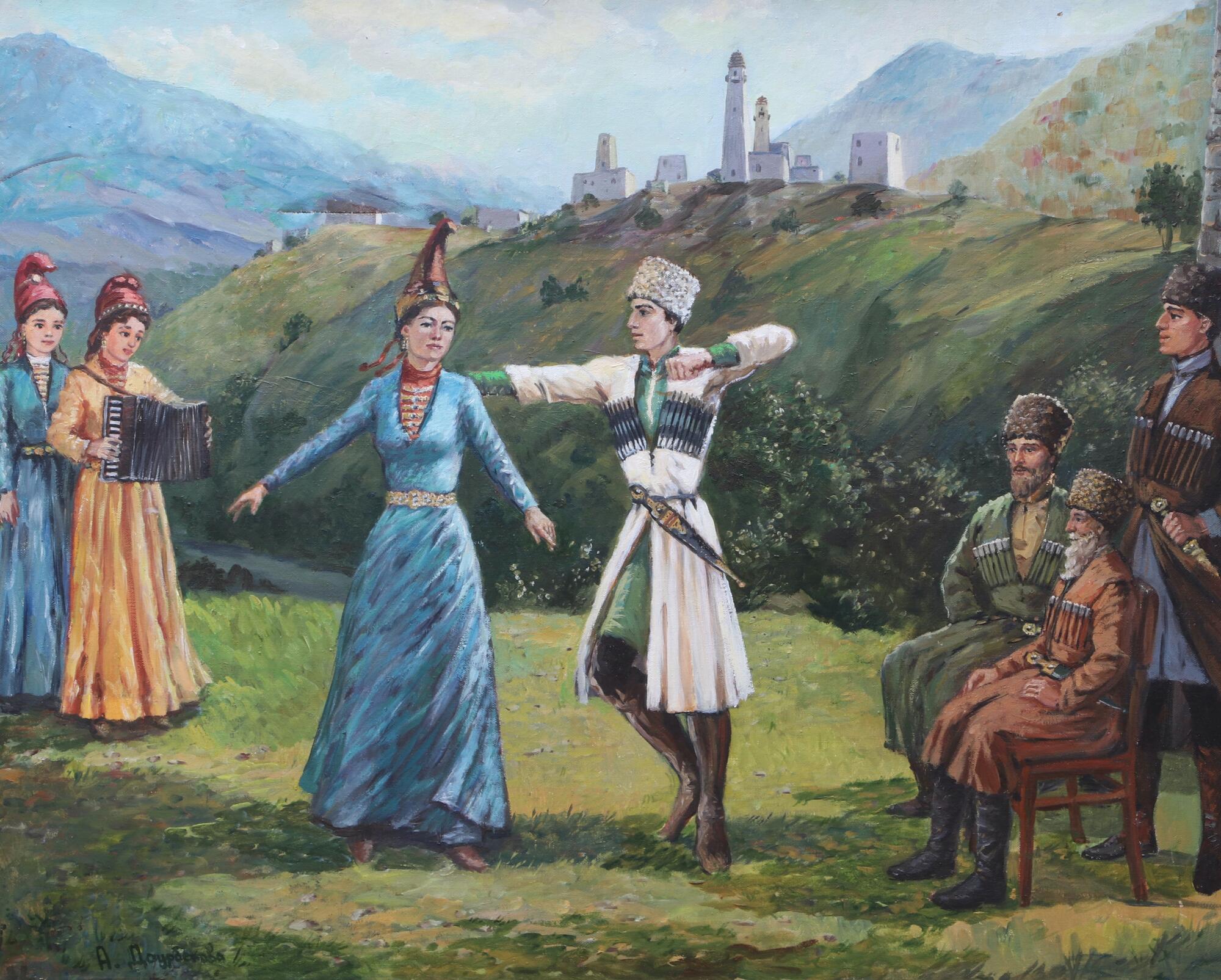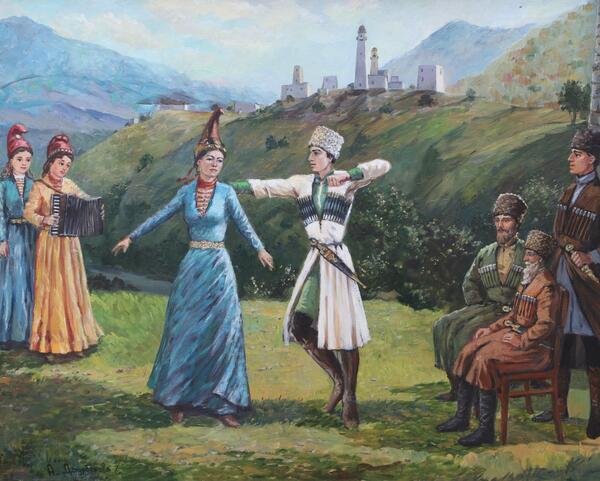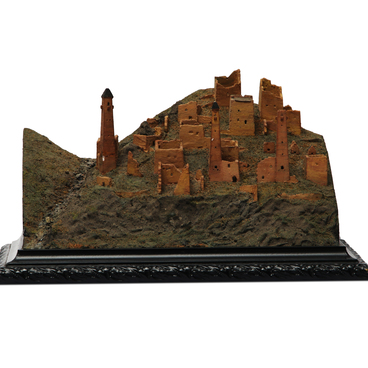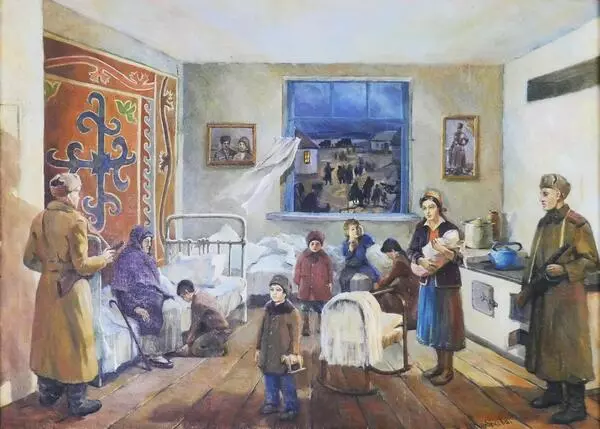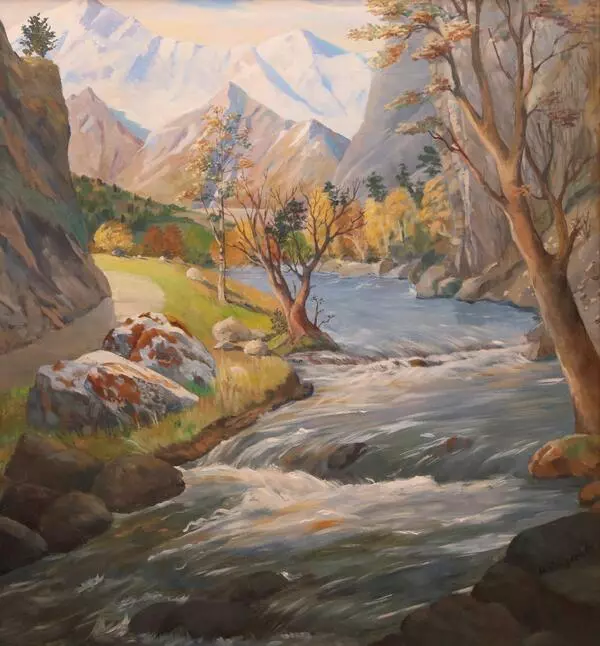The title of the painting ‘Lovzar’ can be translated as ‘game, fun’ or ‘wedding’. The verb ‘lovza’ means ‘to play, to have fun’.
According to one of the versions, initially lovzar was not a simple festive celebration, but a special game, where young men competed in military skills and proved their speed, strength, horsemanship and abilities to use weapons. Gradually, this word was used to denote folk festivals, during which they arranged horse races, sang songs, and danced. Presently, this word means cheerful crowded festivities, including weddings.
Aishat Daurbekova depicted one of the elements of the lovzar — the dance. Dancing (‘khalkhar’) has always played an important role in the culture of the Ingush people. People dance to celebrate the birth of a child or an important guest, during festivities and after belkha — a tradition when many people would gather to collectively build a new house for someone.
The basis of the Ingush folk choreography is a couple dance. It is based on the Ingush ethical norms: the young man determines the movement of the young woman. This tradition refers to life itself, where men take on the role of the head of the family, and women become their helpers and homemakers.
The men’s traditional dance mainly included accurate movements that showed the courage and physical strength of a young man. At some point, a man rose on his toes to demonstrate the flight, spirituality, and sincerity of feelings. The women’s dance, in turn, demonstrated grace and modesty. A woman danced looking down and made short and light steps as not to touch the hem of the dress.
Painter Aishat Daurbekova is a People’s Artist of Ingushetia, a member of the Artists’ Union of Russia. She is primarily known as a landscape painter. The craftswoman works a lot in the suburbs of Ingushetia, often goes to draw en plein air to the mountainous regions, she is interested in the ethnography and folklore of her people. In the painting ‘Lovzar’ she conveyed the spirit of the national dance with great skill, depicting young women and men against the background of a majestic mountainous landscape.
According to one of the versions, initially lovzar was not a simple festive celebration, but a special game, where young men competed in military skills and proved their speed, strength, horsemanship and abilities to use weapons. Gradually, this word was used to denote folk festivals, during which they arranged horse races, sang songs, and danced. Presently, this word means cheerful crowded festivities, including weddings.
Aishat Daurbekova depicted one of the elements of the lovzar — the dance. Dancing (‘khalkhar’) has always played an important role in the culture of the Ingush people. People dance to celebrate the birth of a child or an important guest, during festivities and after belkha — a tradition when many people would gather to collectively build a new house for someone.
The basis of the Ingush folk choreography is a couple dance. It is based on the Ingush ethical norms: the young man determines the movement of the young woman. This tradition refers to life itself, where men take on the role of the head of the family, and women become their helpers and homemakers.
The men’s traditional dance mainly included accurate movements that showed the courage and physical strength of a young man. At some point, a man rose on his toes to demonstrate the flight, spirituality, and sincerity of feelings. The women’s dance, in turn, demonstrated grace and modesty. A woman danced looking down and made short and light steps as not to touch the hem of the dress.
Painter Aishat Daurbekova is a People’s Artist of Ingushetia, a member of the Artists’ Union of Russia. She is primarily known as a landscape painter. The craftswoman works a lot in the suburbs of Ingushetia, often goes to draw en plein air to the mountainous regions, she is interested in the ethnography and folklore of her people. In the painting ‘Lovzar’ she conveyed the spirit of the national dance with great skill, depicting young women and men against the background of a majestic mountainous landscape.
